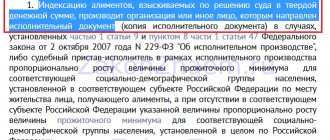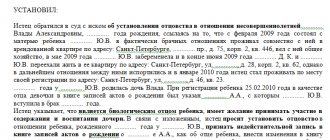14
To automatically enter data about the father into children's documents, the parents must be in a registered marriage. Otherwise, a procedure to establish paternity will be required. Sometimes a man dies before he has time to submit an application to the registry office. In such a situation, the child is deprived of the right to be officially called his son or daughter. In addition, he loses all property rights associated with the death of his father. The law provides for the possibility of entering data about the father into children's documents in the event of his death. To do this, it is necessary to apply to the court with a statement of claim to establish the fact of recognition of paternity after the death of the father.
Procedure for establishing the fact of recognition of paternity
The emergence of paternal rights and responsibilities is tied to the moment paternity is established. The law provides for the following ways of establishing paternal rights:
- the mother and father were married at the time of the child's birth;
- the child was born within 300 days after the divorce;
- the citizen submitted an application to the civil registry office to establish paternity (with the consent of the district guardianship department);
- mother and father submitted a joint application to the district registry office;
- the court made a decision to establish paternity at the request of the interested party;
- the court established the fact of recognition of paternity by the deceased citizen (Article 50 of the RF IC).
Expert opinion
Stanislav Evseev
Lawyer. Experience 12 years. Specialization: civil, family, inheritance law.
The last option applies if a citizen died before he was able to apply to the registry office with an application to recognize the child. The procedure is carried out exclusively in court.
The applicant independently decides whether to change his surname to his father's surname. However, the patronymic name must be brought into line with the father’s data.
Important! If the decision is made in relation to a child aged 10 years or older, then to change the surname it is necessary to find out his opinion (Article 59 of the RF IC).
The second group of evidence consisted of appeals to government agencies.
It was established that the deceased, during his lifetime, submitted an application to the Pension Fund of the Russian Federation for the distribution of his pension savings in the event of his death. In this application, he asked to transfer his pension savings in the event of his death to his children, including his youngest son, the trustee’s child. There were also statements from the deceased to various administrative authorities, in which he also indicated that he had a child, indicating his full name. These documents were also requested by the court at my request.
Why is it necessary to establish the fact of recognition of paternity?
A feature of the statement of claim is the need to indicate the reasons for which this legal fact is required. The applicant must directly and openly state why he needs information about the father in the children's documents.
In practice, the following options are possible:
- in memory of my father;
- to apply for a survivor's pension;
- to obtain inheritance rights.
Thus, as a result of establishing the fact of paternity, the child receives not only family ties formally, but also legally. The son or daughter receives all property benefits due to official children.
Proof process:
Separate attention should be paid to the process of proof in the case under consideration. Proof was complicated by the fact that the potential father of the child had died, which in turn complicated the forensic molecular genetic examination. The expert’s conclusion, although it is serious evidence in this category of cases, is not the only one possible.
During communication with the trustee, it was established that we will be able to present to the court a body of evidence confirming the paternity of the deceased, and if the examination cannot be carried out, we will be able to operate with the specified evidence.
Proper plaintiff
The law limits the list of persons who can go to court.
Proper plaintiffs
| No. | Proper plaintiff |
| 1 | Mother of a minor child |
| 2 | Legal representative of a minor child (guardian, trustee) |
| 3 | Administration of the orphanage (in relation to the organization's pupil) |
| 4 | Guardian of an adult incompetent child |
| 5 | The child himself, over 18 years old |
The authority of the plaintiff must be documented. For example, the mother provides the child’s birth certificate and her civil passport. If the minor has reached 14 years of age, then his passport is additionally attached.
Issuance of an amended birth certificate
After the court’s verdict, you should go to the registry office in order to change the registration record and obtain new documents. You must have with you documents confirming this right:
- the court's decision;
- a document confirming payment of the state duty;
- old birth certificate;
- applicant's passport.
Civil registry office employees may additionally require a passport and power of attorney for the child’s representatives. After reviewing the documents provided, an amended birth certificate will be issued.
The death of the father of the family, who did not legitimize the relationship with the mother and did not recognize the child, occurs quite often. In such situations, mothers or official representatives have the right to write a statement of claim, which should outline the essence of the problem and their requirements. It is worthwhile to first resolve possible disputes with interested parties so that the proceedings take place in a shortened version. If the circumstances are positive, the case will be won in 1 meeting.
Algorithm of actions
In practice, the procedure can be divided into the following stages:
- Collection of documents.
- Preparation of a statement of claim.
- Payment of duty.
- Sending documents to court.
- Trial.
- Obtaining a court decision.
- Making changes to the birth record.
Collection of documents
List of documentation for applying to court:
- the applicant's civil passport;
- an extract from the house register;
- father's death certificate;
- child's birth certificate;
- fee payment receipt;
- petition to bring witnesses;
- photos and videos of the deceased and the child;
- correspondence (letters, SMS, screenshots from instant messengers);
- bank account statement showing the receipt of funds for child support from the deceased.
One of the indisputable proofs is the result of a DNA study. However, in the case of establishing the fact of recognition of paternity, the study can be carried out with other relatives (parents, brothers, sisters, aunts, uncles, grandparents of the father).
If the applicant has the results of a DNA test in hand, then it can be attached as evidence. Otherwise, you can prepare a petition to appoint an examination.
Features of preparing a statement of claim
Regardless of the method of consideration of the application, the plaintiff must prove the paternity of the deceased. The burden of proof rests with the approver. Therefore, it is necessary to pay special attention to preparing the evidence base.
An important condition is the presence of witnesses on the part of the deceased. The relative must:
- recognize the child as the son of the deceased;
- confirm that the deceased recognized the child as his own;
- refute the fact of the confession.
If relatives live in another country or refuse to attend the court hearing, the court will proceed from the evidence provided by the plaintiff.
Payment of duty
Often, posthumous paternity determination is a claim to protect the interests of a minor child. Therefore, an applicant acting on behalf of a minor is exempt from paying the fee.
If the application is submitted by a child who has reached 18 years of age, or by a guardian of an incapacitated citizen, then a fee of 300 rubles must be paid. The original receipt is attached to the claim.
Referral to court
The procedure for establishing the fact of recognition of paternity differs slightly from the option for considering an application. The review period varies depending on the option.
Depending on the situation, the issue can be resolved:
- In the procedure of claim proceedings (Section 2 of the Code of Civil Procedure of the Russian Federation). Applicable when there is a dispute. For example, relatives of the deceased refuse to recognize a family connection. As a rule, the new relative is the priority heir. Therefore, other recipients of property do not want a competitor to appear. The procedure may take a long time.
- By way of special legal proceedings (Section 4 of the Code of Civil Procedure of the Russian Federation). Applies if other relatives are absent or have no objections. This option is often used if there is no inherited property left after the deceased. The application is considered in one meeting. The applicant's request is satisfied.
Trial
The legal process varies depending on the order in which the application is processed.
When considering the application, the plaintiff must prepare a short speech. It should contain the following information:
- about the cohabitation (close communication) of the mother of the child and the deceased;
- information about pregnancy;
- about the deceased man’s attitude towards his girlfriend’s pregnancy;
- whether he met her from the maternity hospital;
- whether he gave money for the maintenance of a minor,
- did you buy him gifts?
- whether publicly recognized as a son/daughter.
In addition, the court hears witnesses (neighbors, friends, relatives).
Specialists from district guardianship departments and registry offices are invited to participate in the process. A specialist from the guardianship department gives an opinion if the application is submitted to protect the interests of a minor.
If there is insufficient evidence, the court may order a DNA test. Comparative material is taken from a relative of the deceased and from the child. Payment for the examination is borne by the plaintiff. In accordance with the results of the analysis, a decision is made.
Obtaining a court decision
If the court has satisfied the plaintiff's request, then it is necessary to obtain a court decision. The document is issued on the day of announcement, but comes into force only after 30 days.
Forensic molecular genetic examination:
Despite the presence of a body of evidence, I considered that it was necessary to apply for a forensic molecular genetic examination. By sending a number of legal requests, it was established that such an examination can be carried out in two ways: 1) using the preserved biological material of the deceased 2) by collecting material from his relatives (parents, children, brothers, sisters).
In the case described, during the autopsy of the deceased, biological material was preserved, packed in paraffin blocks, which, according to the response of the expert institution, could be used for examination.
Also in the case were defendants - relatives of the deceased, from whom the biological material necessary for the examination could also be obtained.
Taking into account the available initial data, a request was made to conduct a forensic molecular genetic examination, the production of which was entrusted to a state expert institution.
For the examination, biological material of the deceased was sent, and biological samples of his relatives were also taken.
According to the conclusions of the examination, it followed that the deceased was the biological father of the trustee’s child.
Is it possible to determine kinship?
Based on Art. 49 and 50 of the RF IC, the mother of a minor has the right to file an application and establish a blood relationship with the deceased through special or claim proceedings. The case is being considered in court.
This may be required in the following situations:
- participation of a minor in the inheritance procedure;
- desire to establish biological relationship;
- to apply for a pension in connection with the loss of a breadwinner;
- to receive compensation payments if a man died from a violent death while performing his official duties.
Note! The initiator of determining a biological connection can be the mother, guardian or trustee of a minor. If a person is over 18 years old, only he or she has the right to carry out the procedure. An exception is the incapacity of an adult: his interests are represented by guardians.
Relatives' objection
The standard procedure for registering family ties through the court is accompanied by the participation of relatives of the deceased:
- parents,
- grandmothers,
- grandfathers,
- aunts,
- uncles.
Close men may object for obvious reasons: if a relationship is established, the plaintiff’s daughter or son will be able to claim the inheritance.
If you find yourself in such a situation, you need to rely on the judge’s opinion. Often, judges do not grant defendants’ objections without specific grounds; besides, you can present additional arguments and facts in your favor.
The decision can be made without a DNA test.
The marriage was not registered
Determination of blood relationship is required if the marriage of the biological parents was not concluded in the registry office.
If a child was born during marriage or within 300 days after its dissolution, the father is automatically entered as the man with whom his mother is in an official relationship.
The man did not recognize the relationship
The refusal of the deceased to recognize himself as the father during his lifetime is not grounds for refusing to satisfy the application. The full answer is contained in paragraph 23 of the Resolution of the Plenum of the Armed Forces of the Russian Federation dated May 16, 2017 No. 16: if the father was not married to the mother of a minor, the case is considered through special proceedings taking into account the norms of the Code of Civil Procedure of the Russian Federation.
The plaintiff must present the facts.
They depend on the date of birth of the son or daughter, whose biological affiliation is proven:
- Born on March 1, 1996 or later. The provisions of Art. 49 RF IC. You will need explanations from the mother, witness testimony, physical and written evidence, video and audio recordings, and expert opinions.
- Birth from 10/01/1968 to 03/01/1998. The evidence is listed in Art. 48 of the “Code on Marriage and Family of the RSFSR”: cohabitation, household management by mother and father before and after the birth of a child.
The man did not deny the relationship
When children are born out of wedlock and in the event of the death of a man, a biological relationship can be recognized through special proceedings if he recognized himself as the father. Any facts are used: testimony of witnesses that the man called the minor his son (daughter), correspondence, etc.
Consideration of the application in court
During the trial, the judge will listen to all witnesses and evaluate the strength of the evidence.
All dates will be checked for consistency and authenticity. If the court finds the plaintiff's arguments convincing, then a positive decision on the claim will be made. The party that loses the lawsuit fully pays for the services of lawyers, genetic testing, and other legal costs and reimburses them to the person who won the case. When a child is recognized as the son or daughter of the deceased, regardless of what judicial procedure was applied for this, he receives all the legal rights of the son or daughter of the deceased:
- the child can change his patronymic and surname;
- he has the right to communicate with his new relatives;
- receives the right to a survivor's pension;
- the right to compensation when the father died due to the fault of other people;
- the child receives the legal right to be the primary heir to the deceased's property.






